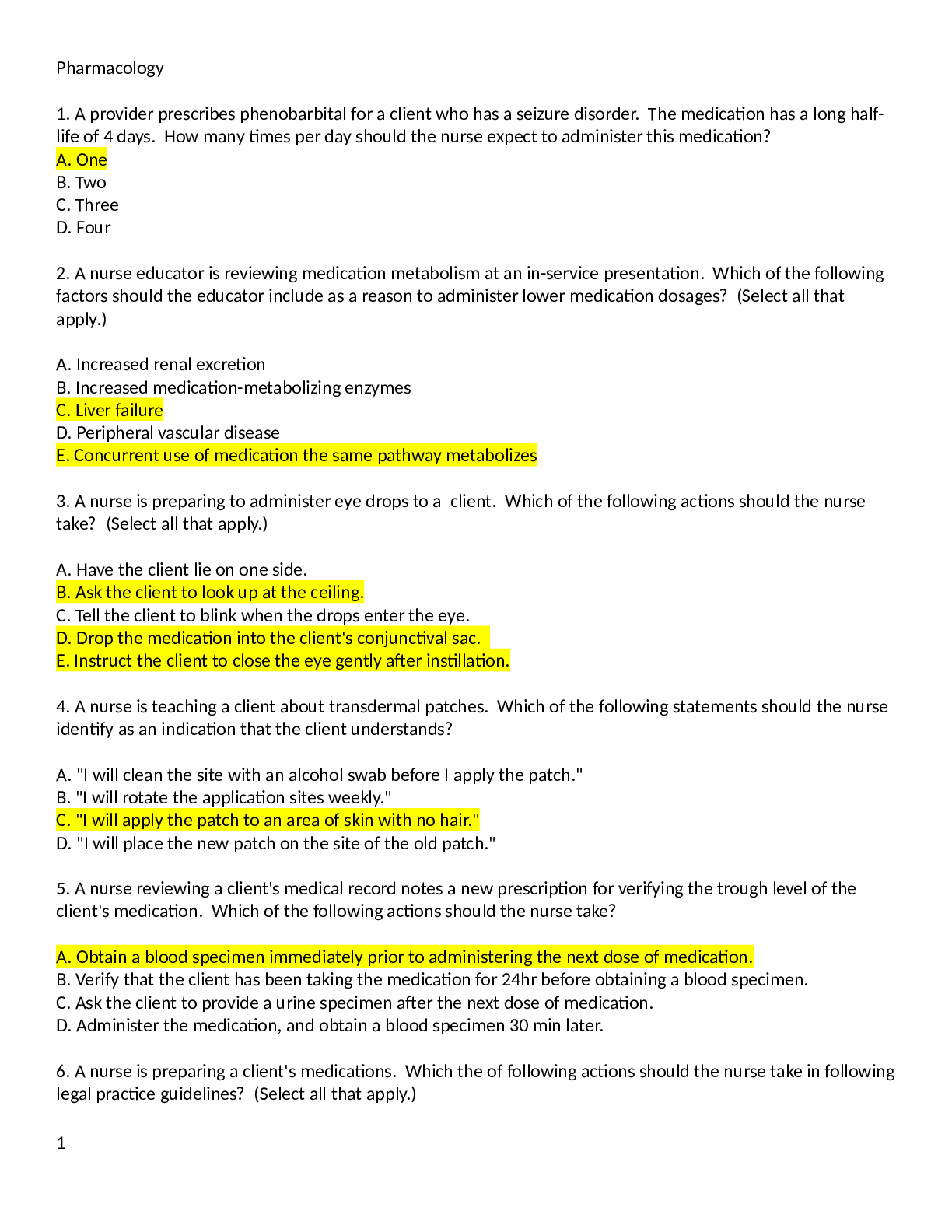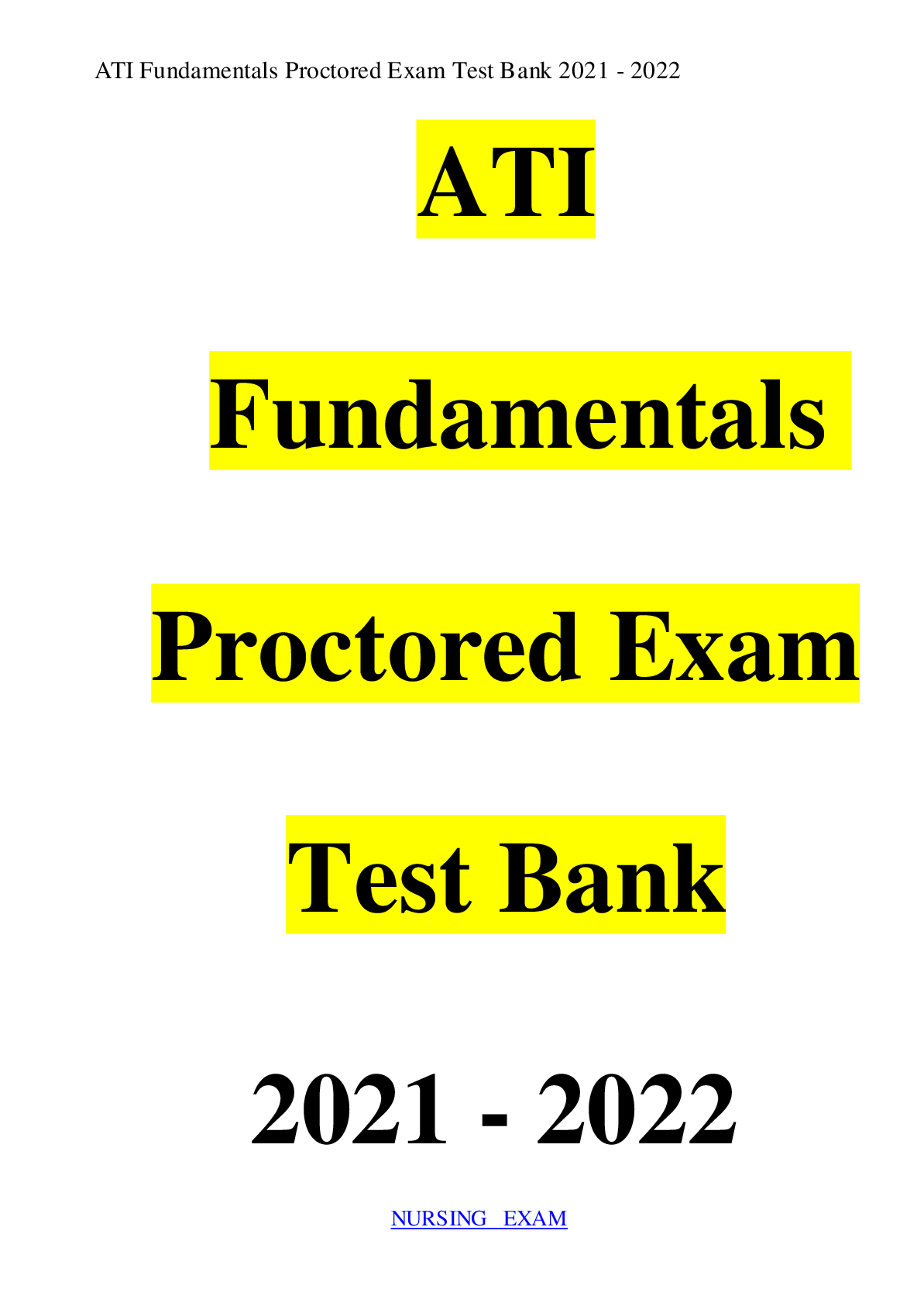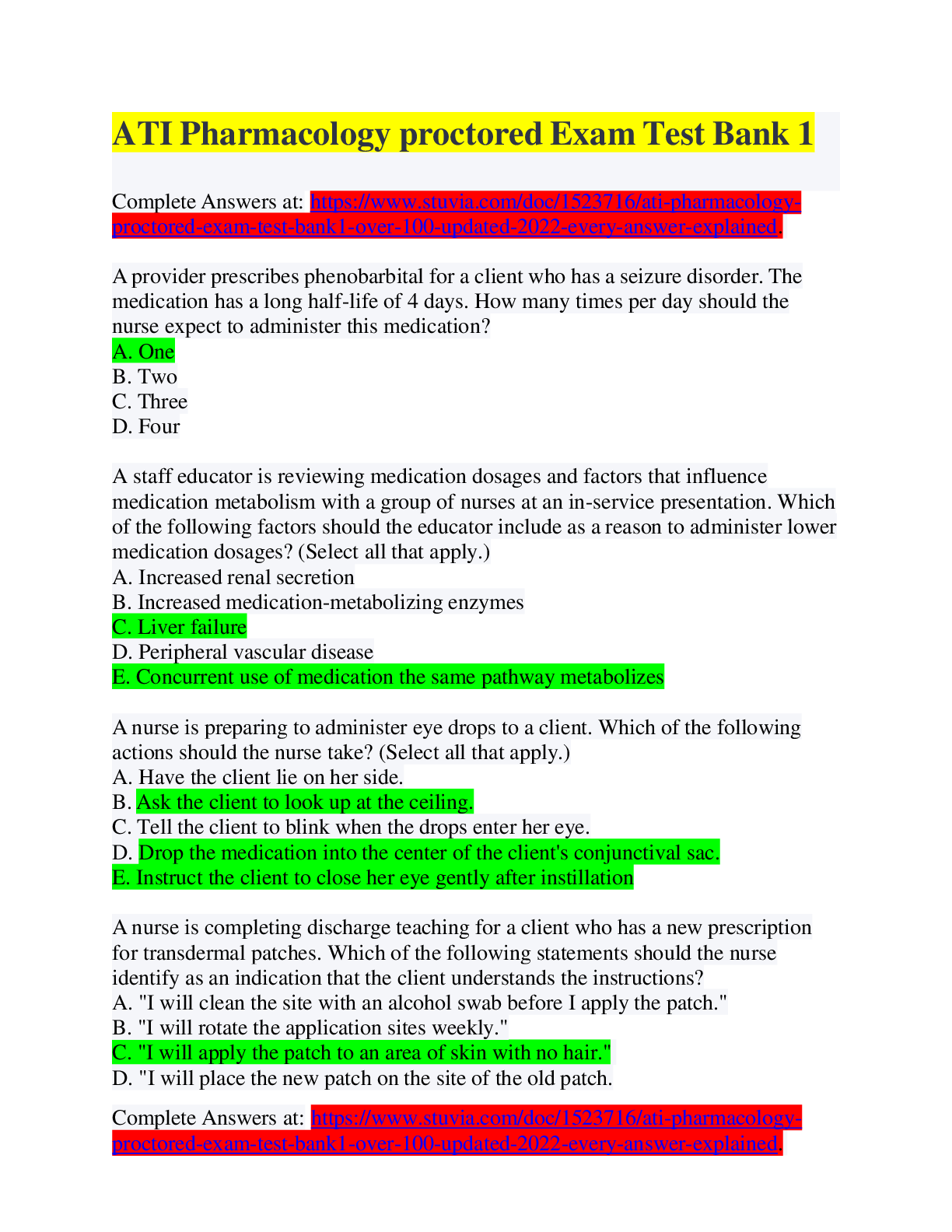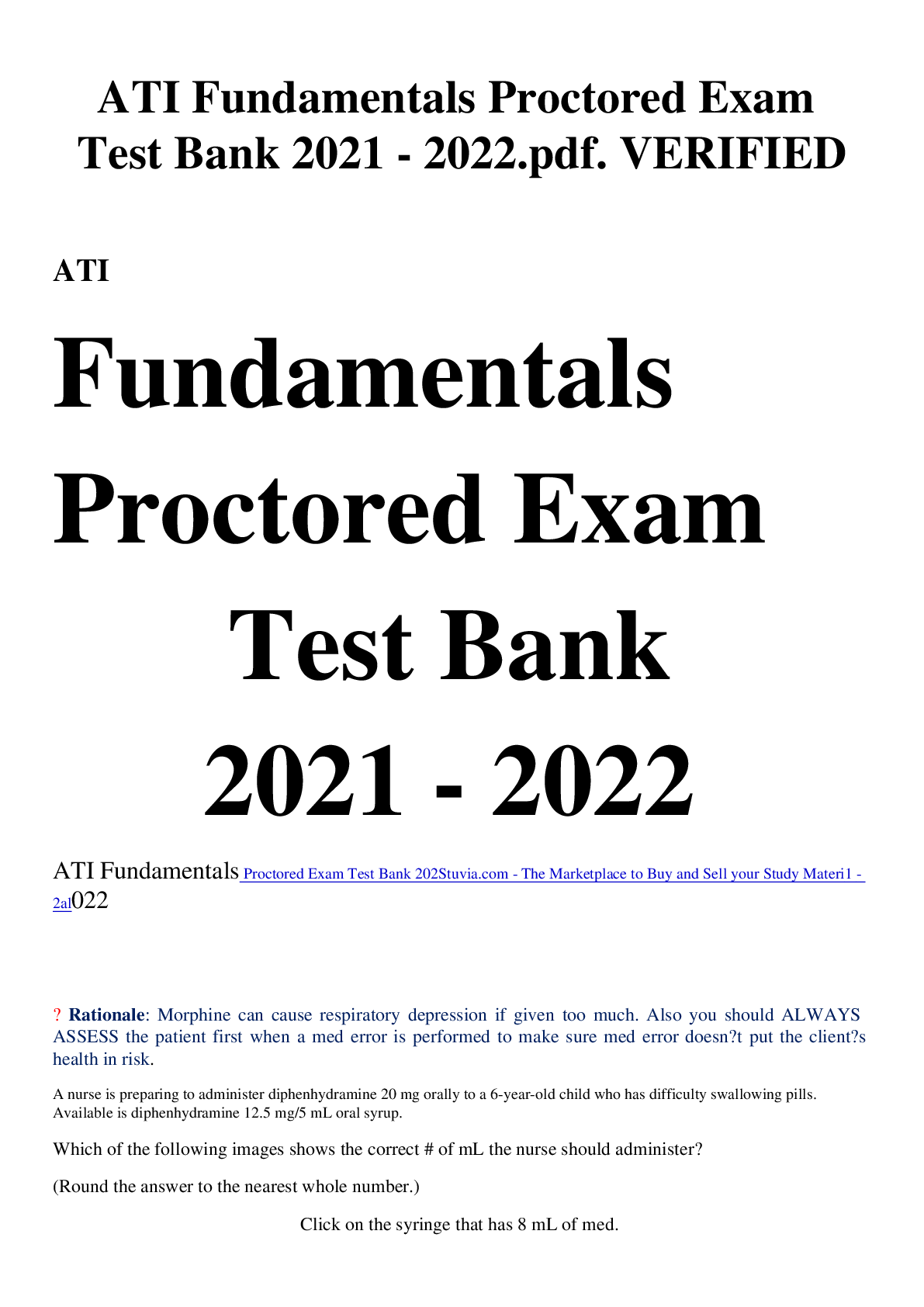*NURSING > QUESTIONS & ANSWERS > MedSurg RN Proctored Exam Test Bank A Latest Updated 2022 and Rated A. (All)
MedSurg RN Proctored Exam Test Bank A Latest Updated 2022 and Rated A.
Document Content and Description Below
ATI Proctored Exam Medical Surgical Form A 1. A nurse is preparing to administer thrombolytic therapy to a client who had an ischemic stroke. Which of the following is an appropriate nursing action?... -Start the therapy within 8 hrs. (within 6 hrs.) -Insert an indwelling urinary catheter after therapy begins -Monitor blood pressure every 30 minutes during infusion. -Elevate the head of the bed between 25 and 30 degrees (to reduce ICP & promote venous drainage, ATI page 89) 2. A nurse is teaching a client about the use of an incentive spirometer. Which of the following instructions should the nurse include in the teaching? -Place hands on the upper abdomen during inhalation. -Exhale slowly through pursed lips. -Hold breath about 3 to 5 seconds before exhaling. (ATI page 138) -Position the mouthpiece 2.5 cm (1 in) from the mouth. 3. A nurse is assessing a client who is 12 hr. postoperative following a colon resection. Which of the following findings should the nurse report to the surgeon? -Heart rate 90/mm -Hgb 8.2 g/dL -Gastric ph of 3.0 -Absent bowel sounds Recall that bowel sounds are altered in patients with obstruction; absent bowel sounds imply total obstruction. QSEN: Safety (Book page 1143) 4. A nurse is caring for a client who has diabetes insipidus. Which of the following medications should the nurse plan to administer? -Regular Insulin -Furosemide -Desmopressin -Lithium Carbonate Teach patients with diabetes insipidus the proper way to self-administer desmopressin orally or by nasal spray. Management focuses on controlling symptoms with drug therapy. -The most preferred drug is desmopressin acetate (DDAVP), a synthetic form of vasopressin given orally, as a sublingual “melt,” or intranasally in a metered spray. The frequency of dosing varies with patient responses. Teach patients that each metered spray delivers 10 mcg and those with mild DI may need only one or two doses in 24 hours. -For more severe DI, one or two metered doses two or three times daily may be needed. 5. A nurse is admitting a client who has arthritic pain and reports taking ibuprofen several times daily for 3 years. Which of the following test should the nurse monitor? Stool occult blood -Urine for white blood cells -Fasting blood glucose -Serum calcium Assess for drug-related blood loss such as that caused by NSAIDs by checking the stool for gross or occult blood. Older white women are the most likely to experience GI bleeding as a result of taking these medications. (Book page 324) 6. A nurse in the emergency department is assessing a client. Which of the following actions should the nurse take first? (Click on the “Exhibit” button for additional information about the client. There are three tabs that contain separate categories of data.) -Obtain a sputum sample for culture. -Prepare the client for a chest x-ray. -Initiate airborne precautions (question sounds like a respiratory issue) -Administer ondansetron. 7. A nurse is contacting the provider of a client who has cancer and is experiencing breakthrough pain. Which of the following prescriptions should the nurse anticipate? -Intravenous dexamethasone -Transmucosal fentanyl -Oral acetaminophen- not strong enough -Intramuscular meperidine Fentanyl is a lipophilic (readily absorbed in fatty tissue) opioid and, as such, has a fast onset and short duration of action. It is recommended opioid for patients with end-organ failure because it has no clinically relevant metabolites. It also produces fewer hemodynamic adverse effects than other opioids; therefore, it is often preferred in patients who are hemodynamically unstable such as the critically ill. (Book page 59) 8. A nurse is admitting a client who reports chest pain and has been placed on a telemetry monitor. Which of the following should the nurse analyze to determine whether the client is experiencing a myocardial infarction? -QRS duration -ST segment -T-wave PR interval Examine the ST segment. The normal ST segment begins at the isoelectric line. ST elevation or depression is significant if displacement is 1 mm (one small box) or more above or below the line and is seen in two or more leads. ST elevation may indicate problems such as myocardial infarction, pericarditis, and hyperkalemia. ST depression is associated with hypokalemia, myocardial infarction, or ventricular hypertrophy. (Book page 670) 9. A nurse is teaching a client who has ovarian cancer about skin care following radiation treatment. Which of the following instructions should the nurse include? -Apply over the counter moisturizer to the radiation site -Cover the radiation site loosely with a gauze wrap before dressing -Use a soft washcloth to clean the area around the radiation site -Pat the skin on the radiation site to dry it. (Book page 390) Skin Protection During Radiation Therapy • Wash the irradiated area gently each day with either water or a mild soap and water as prescribed by your radiation therapy team. • Use your hand rather than a washcloth when cleansing the therapy site to be gentler. • Rinse soap thoroughly from your skin. • If ink or dye markings are present to identify exactly where the beam of radiation is to be focused, take care not to remove them. • Dry the irradiated area with patting rather than rubbing motions; use a clean, soft towel or cloth. • Use only powders, ointments, lotions, or creams that are prescribed by the radiation oncology department on your skin at the radiation site. • Wear soft clothing over the skin at the radiation site. • Avoid wearing belts, buckles, straps, or any type of clothing that binds or rubs the skin at the radiation site. • Avoid exposure of the irradiated area to the sun: • Protect this area by wearing clothing over it. • Try to go outdoors in the early morning or evening to avoid the more intense sun rays. • When outdoors, stay under awnings, umbrellas, and other forms of shade during the times when the sun's rays are most intense (10 AM to 7 PM). • Avoid heat exposure. 10. A nurse is caring for a client who is receiving a blood transfusion. The nurse observes that the client has bounding peripheral pulses, hypertension, and distended jugular veins. The nurse should anticipate administering which of the following prescribed medications? Acetaminophen -Furosemide (this patient has fluid overload from the transfusion) Diphenhydramine Pantoprazole 11. A nurse is assessing a client who is receiving magnesium sulfate IV for the treatment of hypomagnesemia. Which of the following findings indicates effectiveness of the medication? -Lungs clear -Hypoactive bowel sounds- Reduced motility, anorexia, nausea, constipation, and abdominal distention are common. A paralytic ileus may occur when hypomagnesemia is severe. -Blood pressure 90/50 mm Hg-hypomagnesemia causes hypertension, but this is too low, abnormal -Apical pulse 82/min One aspect of the conduction problems is that, when serum magnesium levels are low, intracellular potassium levels are also low. This changes the resting membrane potential in cardiac muscle cells, slowing normal conduction and triggering ectopic beats. 12. A nurse is preparing a client for a lumbar puncture. Which of the following images indicates the position the nurse should assist the client into for this procedure? - “Cannonball position on the side” picture #4 (ATI page 20) 13. A nurse is reviewing a clients ABG results: pH 7.42, PaCO2 30 mm Hg, and HCO3 -21 mEq/L. The nurse should recognize these findings as an indication of which of the following conditions? -Compensated respiratory alkalosis -Uncompensated respiratory acidosis -Metabolic acidosis -Metabolic alkalosis 14. A nurse is preparing to administer daily medications to a client who is undergoing a procedure at 1000 that requires IV contrast dye. Which of the following routine medications to give at 0800 should the nurse withhold? -Metoprolol -Metformin -Fluticasone -Valproic Acid 15. A nurse is planning care for a client who is experiencing seizures secondary to meningitis. Which of the following interventions should the nurse include in the plan of care? (Select all that apply.) -Assist the client to ambulate every 4 hr. -Place a tongue blade at the bedside. -Have suction equipment at the bedside. -Dim the overhead lights. -Apply a warming blanket. 16. A nurse is caring for a client who has a pressure ulcer with necrotic tissue and requires wet to damp dressing changes daily. Which of the following types of debridement should the nurse include in the plan of care? -Enzymatic -Surgical -Autolytic -Mechanical 17. A nurse is caring for a female who has toxic shock syndrome. Which of the following findings should the nurse expect? -Elevated platelet count -Decreased total bilirubin -Generalized rash -Hypertension 18. A nurse is preparing to administer a medication for a client though a non-tunneled percutaneous central catheter. Which of the following actions should the nurse take? -Close the inline clamp -Apply a local anesthetic to the skin -Don sterile gloves -Flush the catheter with 10 mL of 0.9% sodium chloride. 19. A nurse is caring for a client who was admitted with nausea, vomiting, and a possible bowel obstruction. An NG tube is placed and set to a low intermittent suction. Which of the following findings should the nurse report to the provider? -The client reports being extremely thirst with a sore throat -The drainage is bright green in color with brown fecal material -The amount of drainage is gradually decreasing -The client’s abdomen becomes distended and firm. 20. A nurse is reviewing the medical recor [Show More]
Last updated: 1 year ago
Preview 1 out of 18 pages

Reviews( 0 )
Document information
Connected school, study & course
About the document
Uploaded On
Apr 10, 2022
Number of pages
18
Written in
Additional information
This document has been written for:
Uploaded
Apr 10, 2022
Downloads
2
Views
211

.png)
.png)
.png)
.png)
.png)
.png)
.png)
.png)
.png)
.png)
.png)

.png)

.png)
.png)

















